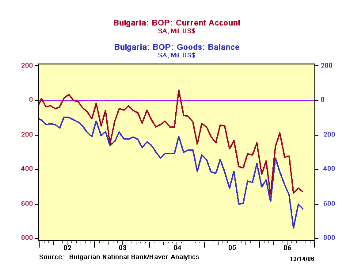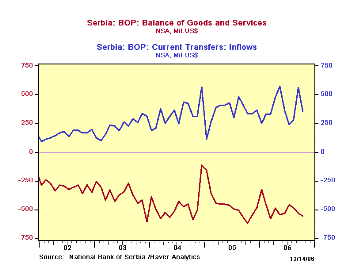 Global| Dec 14 2006
Global| Dec 14 2006Current Accounts in Central Europe: Services, Income and Transfers Play Significant Role
Summary
Four Central European countries reported their October current account results during the day yesterday, December 13. Yesterday in this commentary, we noted that the improvement in Japan's surplus in the month resulted from lower [...]

Four Central European countries reported their October current account results during the day yesterday, December 13. Yesterday in this commentary, we noted that the improvement in Japan's surplus in the month resulted from lower petroleum imports, which were augmented by complementary advances in other current account components. Today, we see that for Poland, Bulgaria, Slovenia and Serbia, developments in those other current account items – services, income and transfers – helped during the summer to mitigate the impact on the current account of larger petroleum imports. But this counterbalance can't be counted on every month and sometimes such increases in merchandise trade deficits are enlarged.
Poland is a good example: its current account deficit widened to $1.23 billion in October from just $82 million in September and $940 million a year ago. As seen in the graph, in most months, the trade portion is only about half the total current account balance. The deficit on income, particularly rising income payments abroad, make for a more complex current account situation.
In Bulgaria, the current account deficit has been steady the last three months at just over $500 million, even as imports of goods have fallen from their August peak of $2,139 million to $1,896 billion. Goods exports also fell and the net on services, generally a surplus in Bulgaria, declined to virtually zero. The moves are small, but they still indicate the intricacy of international trade and financial flows. 
Finally in Slovenia, the trade deficit is offset to some degree by a continuing small surplus in services, although income accounts generally show net outflows and transfers are erratic in both directions.
| Current Account Balances: SA, Mil.$ |
Oct 2006 | Sept 2006 | Aug 2006 | Year-Ago | Monthly Averages|||
|---|---|---|---|---|---|---|---|
| 2005 | 2004 | 2003 | |||||
| Poland | -1,234 | -82 | -1,192 | -940 | -427 | -891 | -386 |
| Bulgaria | -527 | -509 | -539 | -311 | -255 | -122 | -87 |
| Serbia (NSA) | -330 | -132 | -334 | -344 | -174 | -244 | -161 |
| Slovenia | -58 | -271 | -92 | -33 | -56 | -74 | -18 |
Carol Stone, CBE
AuthorMore in Author Profile »Carol Stone, CBE came to Haver Analytics in 2003 following more than 35 years as a financial market economist at major Wall Street financial institutions, most especially Merrill Lynch and Nomura Securities. She has broad experience in analysis and forecasting of flow-of-funds accounts, the federal budget and Federal Reserve operations. At Nomura Securites, among other duties, she developed various indicator forecasting tools and edited a daily global publication produced in London and New York for readers in Tokyo. At Haver Analytics, Carol is a member of the Research Department, aiding database managers with research and documentation efforts, as well as posting commentary on select economic reports. In addition, she conducts Ways-of-the-World, a blog on economic issues for an Episcopal-Church-affiliated website, The Geranium Farm. During her career, Carol served as an officer of the Money Marketeers and the Downtown Economists Club. She has a PhD from NYU's Stern School of Business. She lives in Brooklyn, New York, and has a weekend home on Long Island.





